|
|
|
|
Products mentioned in this Article
--None--
|
|
|
|
|
|
|
|
|
 |
|
|
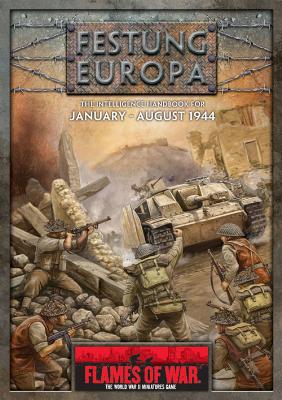 |
“ITALIA, ITALIA, ITALIA!”
By Francesco Mioni
Bersaglieri Division Italia was formed in Heuberg, western Bavaria, on 25 November 1943. Its volunteers were all ex-royal army from all branches and came from prisoners captured after the September armistice. The initial 1,200 officer volunteers underwent extensive training from German instructors until March 1944.
The training was so successful that the newly trained leaders of the Italia Division were utilized to start the training of the Monterosa Division’s ranks while waiting for Italia conscripts from the Vercelli Recruitment Centre.
Initially it had be decided that the Bersaglieri were to be the first RSI division formed (Introduction) due to the quickness that its cadres had reach a good level of preparation.
|
|
However, while General Carloni was waiting for the recruit battalions, news arrived that they had been put at the Germans disposal in Italy. Due to the delay in recruits Italia became the last division in the RSI Army preparation plan.
The first contingents arrived in Germany at the beginning of May, but the main body didn’t reach Heuberg until the end of June.
The composition was particular: with a small percentage of conscripts and a large majority of re-called military service men, many of whom were captured after going into hiding.
On 14 July General Carloni was nominated Commandant Of Monterosa, leaving Italia in the command of General Manardi.
|
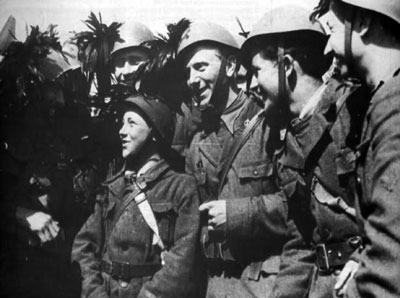 |
• Division Headquarters
|
(Commander: General Mario Carloni: November 1943 through July 1944; General Guido Manardi: July 1944 through February 1945; General Mario Carloni: February 1945 through April 1945).
4th Recce Battalion
4th Anti-tank Company
4th Engineer Battalion
4th Signal Battalion
4th Transport Battalion
54th Replacement Battalion
4th - 7th - 8th MP sections
|
• DVK 180
|
(Deutsche Verbindungs Kommando, German Liaison Unit)
|
• 1st Bersaglieri Regiment:
|
HQ Company;
Light Column;
107th Cacciatori Carri (Tank Hunters) Company;
I, II and III Bersaglieri Battalions
|
• 2nd Bersaglieri Regiment:
|
HQ Company;
Light Column;
108th Cacciatori Carri (Tank Hunters) Company;
I, II and III Bersaglieri Battalions
|
• 4th Artillery Regiment:
|
4 Groups (=Battalions):
1 Group with 100/17 field guns,
3 Groups with 75/13 mountain guns
|
|
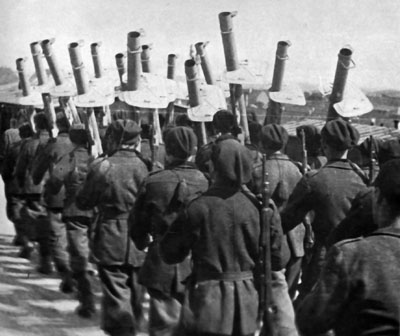
A unit of 4th Anti-tank Company. Note the fez cap,
typical of Bersaglieri Corps.
|
The 14,000 Bersaglieri received the same equipment as the other RSI divisions, but they were forced, more than once, to give armaments and materials up to German Units that were quickly formed to be sent to the western front and reinforce army corps fighting to defend the Reich.
These facts renewed rumours about the possible dissolution of the division and sending the recruits to TODT organisation; another rumour had size of the unit reduced to a light brigade. The consequence of the German delays was, General Graziani reported to Rahn, at the end of January 1945 25% of Italia soldiers were still unarmed.
To the southern front
At the beginning of December 1944, Italia moved back to Italy to join Monterosa on the Gothic Line and form with it a new Army Corps. Later, when it was necessary to reinforce Alps front, Bersaglieri replaced the Alpini all along their sector.
|
|
The transfer was by train to Verona and then to Parma on foot, due to the great lack of transport.
The movement also became harder owing to abundant snowfalls that made almost impassable the main road to Magra Valley sector. At the end of January only the 4th Recce Battalion had been able to cross Cisa pass to substitute Monterosa units.
Luckier was II Battalion 3rd Regiment, transferred by trucks to replace 285th German Infantry Regiment. It arrived without incident on the front line and deployed with ease. However only a few days later desertions began.
|
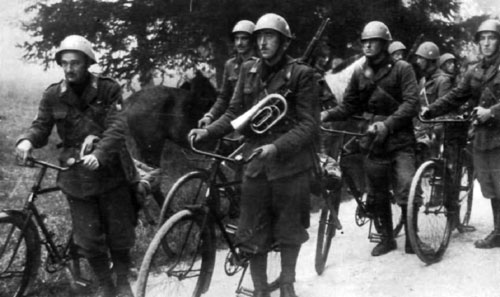
Parma, January 1945. A cyclist platoon take a break during their transit to the front.
|
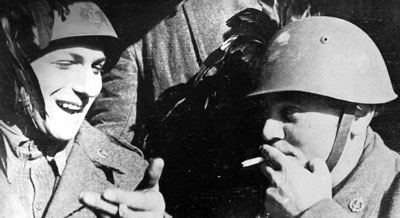 |
Much of the unit was made up of soldiers from the south of Italy, and the temptation to cross the lines and return home proved too much for many.
Even in Italia Division, with its recruitment based on experienced soldiers, began the desertion phenomenon that, according to Carloni, was higher than in other RSI Divisions. The Allies, supposing Bersaglieri resistance would be light, tested the II Battalion 1st Regiment at the end of January. Their attack was initiated with heavy artillery preparation and air raids. U.S. troops attacked in two columns, as had done the Brazilians against Monterosa and San Marco the previous November.
|
Contrary to U.S. predictions, the Italians didn’t abandon their positions. On the second day the Americans became more cautious and enlarged the front of attack to the Serchio River sector, engaging the Monterosa Brescia battalion and the III Bersaglieri battalion, which was in the process of deploying and was without artillery support.
The attack lasted four days with no results for the U.S. troops, however they did inflict heavy losses on the defenders, especially among officers. After the battle the activity along this sector of the front became limited to patrol fighting by both sides.
|
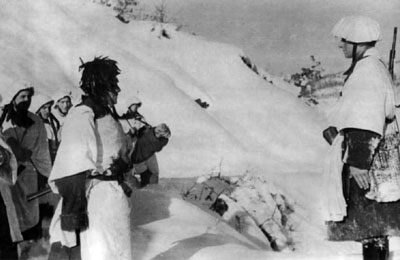
Garfagnana, 1945. Briefing before a patrol.
|
|
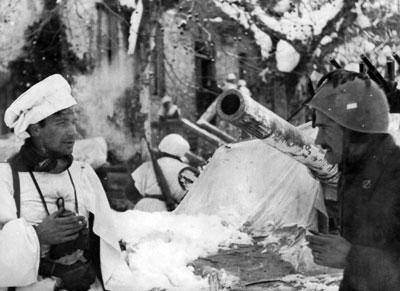
Garfagnana, January 1945, men of the 4th Artillery Regiment.
|
The Allies try again
By March 1945 partisan activities behind the Italia positions became more intense and there was even an increase in desertions from the German units in the sector, especially from the battalion that garrisoned the sector from Treppignano to Nuda.
This battalion had been made from “3 list” men: soldiers from countries recently occupied by the Reich, on whom tiredness, distrust about the course of the war, and anti-German sentiment was compounded by anti-fascist and Allied propaganda. Desertion and unwillingness to fight of this battalion worried not only its commander, but also the Italia Division headquarters under whose command the unit came.
|
|
For these reasons the German unit’s front was attacked by the Americans again and again and more than once the front was on the point of collapsing. The Italia Recce Battalion’s units were called frequently to support the Germans.
The main attempt to break through the Axis front took place in mid March, with an offensive against the Serchio River left sector. During the first day the Americans obtained good penetration, especially in the higher zone, threatening the rear of defenders’ front lines. At dawn the following day American attack’s resumption was halted by an intense barrage from all available guns, reinforced by all the available reserves, which had arrived during the night.
The Americans then tried to change the direction of the offensive, switching to the Italian positions along the right side of Serchio. The attack was unsuccessful and by the middle of the afternoon it was clear that Allies efforts had been exhausted.
At 16.00, after a strong bombardment, an Axis counter-attack was launched, catching by they enemy by surprise, who believed their previous attacks had brought the Italian and German to exhaustion. U.S. artillery counter-battery fire was weak and untidy allowing Italian columns easy progress to the American front lines.
|
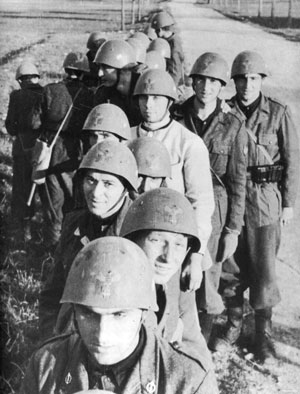 |
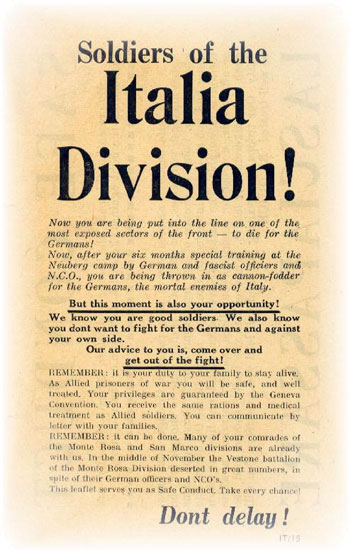
|
The attack, launched in depth, threatened to surround the Americans’ more advance units.
By the evening all American units were withdrawing, taking advantage of terrain’s ravines to avoid encirclement. When dawn broke the front of the Axis positions was free of enemy. A few American units maintained some higher points on left of the Serchio, however they could neither escape nor advance from these positions.
Losses were heavy for both sides and often, because of lack of troop numbers along the first line, difficult situations were solved by artillery alone. The coordination between the artillery and infantry, learnt in the German training camps, gave very good results.
Kampfgruppe Ferrario
A new Allied offensive started on 4 April in front of Massa, along the Tirrenian coast. The German 148. Infanterie Division, on Italia’s right, contained the attack, but a unit of Hawaiian Troops (92nd U.S. Division) was able to penetrate the front line, threatening both divisions’ supply lines.
To stop them was formed Kampfgruppe “Ferrario” (named after the commander of I battalion, 2nd Regiment) from I battalion and II Artillery Group, the “Goffredo Mameli” Bersaglieri battalion (an independent unit that was going to join Italia) and Alpini “Bergamo” Artillery Group.
|
|
Above Left: The front of a leaflet aimed at ’Italia Division’. This is an English translation of the original leaflet, probably given to Allied officers for their information.
Right: The back of the previous leaflet.
The kampfgruppe immediately joined with the 148. Infanterie Division on its right, to consolidate the Axis positions. They immediately engaged the enemy to slow their advance and prevent the Soliera gorge and Aulla village been taken. These two positions were the last obstacles preventing the Allies crossing Apennines and reaching the Padana Plain. These strategic points were also important to Axis troops also being deployed along the south slopes of the mountain range.
|
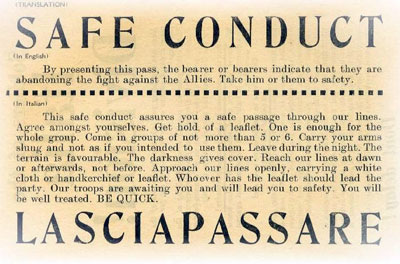 |
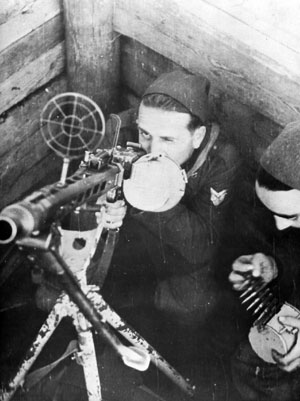 |
Meanwhile, on 15 April, worried by 148. Infanterie Division front line situation and in general by the Allies pressure all along the Gothic Line, Army Corps Command ordered General Carloni to prepare for retreat. The German’s original plan was to conduct a fighting withdrawal along pre-arranged defensive lines to force the Americans to continually attack.
These tactics would have permitted enough time to regain operational initiative, in the Germans’ opinion.
However it could not be implemented because of Italia Division’s lack of mobility and almost total shortage of any way of conducting that sort of mobile warfare. Carloni devised an alternative plan to cross the Apennines through Cerreto pass and ordered the start of withdrawal preparations.
The situation suddenly collapsed on 17 April. The 148. Infanterie Division, on Italia’s right, and the 232. Infanterie Division on the left, defending Abetone and Radici passes, were forced to withdraw, leaving Italians isolated and exposed to the advancing U.S. troops from the left and right.
Thanks to Carloni’s experience, matured in similar situations in Russia, he began to skilfully manoeuvre his division out of direct confrontation with the American forces, avoiding contact.
|
|
In fact during last days along Italia Division’s front Allied activity had been limited to patrol actions and heavy barrages to prevent both reserve transfer to other sectors and the division’s retreat. They hoped to close off any escape routes with advances on the Italia Division’s flank.
The retreat
On the evening of 19 April Bersaglieri deployed along the Garfagnana front line started to break off, leaving rear guards that retreated the following night. Only on 21 April U.S. vanguards regain contact with Italia. Carloni ordered two battalions of the 1st Regiment (colonel Zelli) to stop and defend, with 148. Infanterie Division units and Kampfgruppe Ferrario, the hills above Soliera.
|
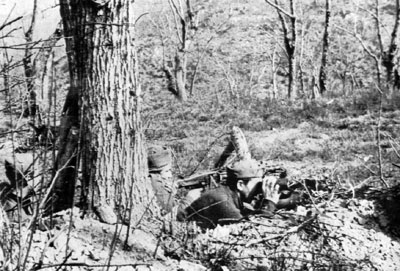
Garfagnana, April 1945, MG-42 position.
|
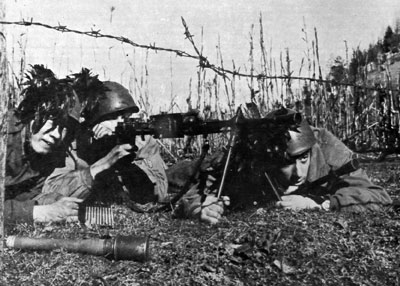 |
It was considered fundamental to maintain control of that position, permitting the two divisions to cross Soliera Bridge and continuing retreating along Soliera-Aulla road to Cerreto pass.
At about 12.00 Intra Alpini Battalion informed the Italia HQ that fast enemy columns had cut the Cerreto road and the pass itself was under artillery fire. Army Corps command then changed the original plan: Italia units, not yet passed through Cerreto, would have to withdraw to Cisa pass on to the Fornovo-Parma road, and join the “Fretter-Pico” Division Group.
The afternoon was employed issuing the new order, delivery was complicated because the division was avoiding radio communications. The Italians were almost sure enemy had got Axis cipher codes.
|
|
Kampfgruppe Zelli’s resistance allowed the remaining Italia units to cross Soliera Bridge, even if under heavy artillery fire. The effects of the artillery was clear on 23 April when Bersaglieri broke contact with enemy, the bridge was damaged and not crossable by wagons and they were forced to change their route towards Licciana Nardi. Two days earlier the II battalion 1st Regiment had passed through the same village. It had been sent to Licciana to free the way for the “Intra” Battalion, which was retreating from Cerreto pass.
However the commander, captain Ciancio, didn’t obey the order, instead of covering other units’ march he allowed his soldiers to rest in the school building without adequate sentries.
|
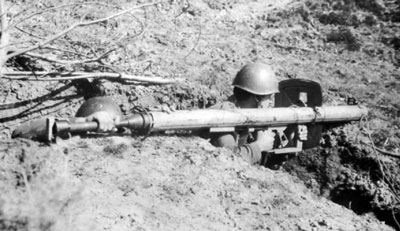 |
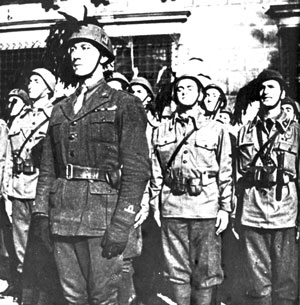 |
It is unsure what happened between Bersaglieri and partisans, but II Battalion never reached division assembly place. The following day when the “Intra” Alpini arrived at Licciana, believing to be preceded by Bersaglieri, they were suddenly attacked by partisans and, after hard fighting, only half the regiment was able to disengage and rejoin Italia. The same happened on 24 April with Kampfgruppe Zelli, Partisans blocked the way and asked Zelli to surrender. His refusal was followed by his unit breaking through the blockade and that evening the survivors joined the Division HQ in Villafranca.
From 24 to 26 April, reinforced by Italian troops from Riviera Ligure and under constant air raids, Italia crossed Cisa pass towards Parma. The road to Parma was blocked by the Brazilians in Medesano, along the Taro River. It was to be Italia last battle.
The “Intra” Alpini Regiment, I Battalion 1st Regiment, sailors from Liguria and other units were launched against the enemy, who, after a desperate battle, was forced to abandon their positions. In spite of the success, the general situation was desperate. Carloni met Fretter-Pico, 148. Infanterie Division commander, on the evening of 27 April.
|
They were contacted by the Allies and at 14.00, 29 April 1945 the IV RSI Division were consigned to the pages of history. After have destroyed the regimental flags, Carloni arrived at the Brazilian headquarters to hand over the Italia division’s surrender.
|
Last Updated On Tuesday, June 19, 2007 by Wayne at Battlefront
|
|
|